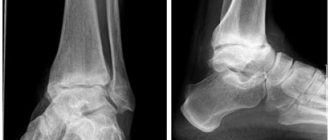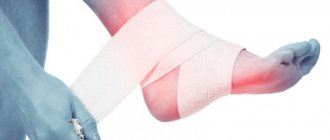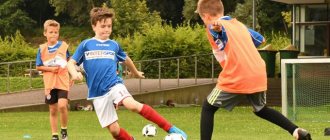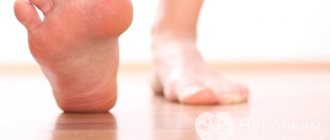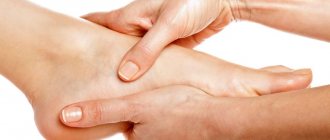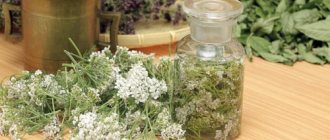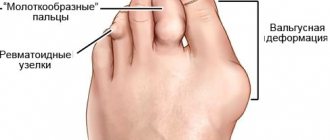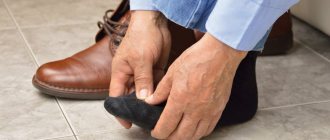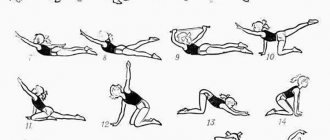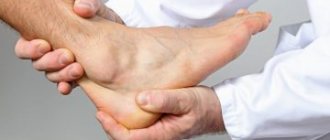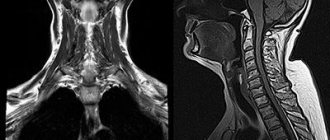Osteoarthritis of the foot is a chronic disease of the joints, which entails the destruction of articular cartilage and bone deformation. It is degenerative-dystrophic in nature and is manifested by pain when walking, limitation of movements and a sharp decrease in the supporting function of the leg. It is also characterized by enlargement of the joint due to stable swelling of the soft tissues. The incidence of the disease increases with age. For statistics, primary or secondary arthrosis of the foot , the treatment of which requires immediate treatment, is detected during examination in 85% of women and men. Age group – after 55 years.
Etiology of arthrosis of the joints of the feet
There are two types of arthrosis:
- Primary. Appears as a result of metabolic disorders in cartilage tissue and is accompanied by a disorder of the functions of its main cells - chondrocytes.
- Secondary. Caused by abnormal development of articular and bone tissues, injuries, metabolic, endocrine and other factors and diseases that damage articular cartilage.
When treatment for arthrosis of the foot is required: risk factors
- Genetic predisposition.
- Acquired (old age, excess weight, inflammatory and other bone diseases, joint surgeries, constant hypothermia of the legs, poor nutrition).
- External (excessive load, injuries, dislocations, intra-articular fractures, wearing tight high-heeled shoes).
Gymnastics
Treatment of arthrosis is impossible without movement. Specially selected exercises will stimulate the restoration of cartilage tissue.
Important!
It is a mistake to believe that rest is necessary for arthrosis of the joint. Without movement there is no adequate nutrition, and the disease will progress.
Well-chosen exercises help strengthen muscles. The tendons become stronger, and it becomes easier to bear everyday stress.
Walking on a special massage mat has a beneficial effect on diseases of the joints of the feet. It massages the sole and stimulates blood circulation. An alternative to using a special product is to walk on soft ground, sand or grass. It is better to walk barefoot or in socks.
When arthrosis worsens, patients cannot even leave the house. During this period, rolling a tennis ball would be a good exercise. You can use a special foot massager. It is advisable that the surface be pimply, since in this case the simulation will be stronger.
The “bicycle” exercise is good for treating joints. The event is carried out in a supine position. You need to perform circular movements similar to those that occur when riding a bicycle. Joint mobility improves and excess fluid is removed.
Jogging and walking on bent legs have a positive effect. The load on the joints is small, but this position contributes to their development.
During regular exercise, joints become stronger. Mobility is restored, and fingers become stronger and help to better control the body. The flexibility that was there before the onset of the pathology is restored.
Symptoms of arthrosis of the foot
The symptoms of the disease are varied. The degree of its severity may vary depending on the stage of the disease: from mild pain during prolonged standing work to curvature of the fingers and a noticeable change in gait. The most common symptoms of arthrosis of the feet:
- Crunching or squeaking noises when moving (crepitus).
- Swelling, redness of the skin at the site of pathology;
- Painful sensations during physical activity, which lose their severity during rest.
- Weather dependence: dull pain in the joints when the weather changes.
- Deformation of the joints of the feet, increase in their size.
- A change in gait caused by the patient’s natural desire to unload the affected joint.
- Fever.
- Deterioration in performance, increased fatigue, formation of characteristic calluses.
- When the disease is advanced, there is significant deformation of the joints, which becomes noticeable even during an external examination of the leg.
If you notice these symptoms, we recommend that you make an appointment with a doctor to undergo an examination and appropriate treatment for arthrosis of the joints of the foot or heel .
Plantar fasciitis: symptoms, treatment methods, prevention
What is popularly called a heel spur has a medical diagnosis of fasciitis. Even the initial stage of the disease brings severe discomfort - pain in the heel when walking. The disease is divided into:
- Plantar (plantar);
- Necrotic.
Causes
The main reason is prolonged physical activity on the foot. The risk group is middle-aged and elderly people. In addition, this includes professions that predispose to the disease: dancers, gymnasts, track and field athletes, weightlifters, etc. Their lifestyle includes special loads, during which the feet are exposed to daily microtraumas, and general joint pain appears.
Excess weight is an additional provocateur for the appearance of heel spurs. Having been diagnosed with obesity, you should think about proper and balanced nutrition. In addition, the supply of fascia with microelements directly depends on the presence of such diagnoses as:
- arthritis;
- arthrosis;
- gout;
- flat feet;
- diabetes;
- vascular diseases.
Uncomfortable, tight shoes, dress shoes with high heels (especially stiletto heels) are also not the least important on this list. There is another factor that influences the appearance of symptoms. It was believed that walking barefoot brought exceptional health benefits. In fact, it's not like that. This too can cause symptoms of fasciitis. Even at home you need to wear slippers.
Symptoms of the disease
The main symptom is severe pain in the heel when walking in the morning after getting up. Morning pain is explained by the fact that microtraumas of the fascia heal overnight, and after loading the foot they are again exposed to aggressive influence. It happens that by the end of the day the patient is no longer able to walk fully.
A visually noticeable deformation of the foot appears, caused by impaired joint mobility. In addition to acute, piercing or dull pain, cramps in the foot and back muscles of the leg, extensive swelling and general weakness are added.
Diagnosis of fasciitis
If disturbing symptoms appear, you should immediately consult a doctor. It is important to know that in a neglected state, medicine can only alleviate the patient’s suffering through surgery, so you should not delay going to the hospital, as the disease can lead to complications.
Diagnostic methods:
- visual examination and palpation of the foot, survey - to clarify symptoms, profession and other necessary data;
- X-ray examination - detection of bone changes;
- MRI - if there is a suspicion of a rupture of the plantar fascia;
- blood test to check for bacteria that could cause necrotizing fasciitis.
Traditional Treatments
Doctors prescribe a course of therapy individually for each patient. First of all, you need to eliminate the cause - you should reduce excess weight, there should be a regimen, a balanced diet. Athletes are advised to reduce the load on their legs or give up sports altogether. In some cases, patients have to change their type of professional activity if their legs suffer from it. Drugs are used that reduce swelling, inflammation, and relieve pain.
Non-traditional methods (folk remedies)
First of all, you need to know that folk remedies will not replace traditional treatment, but they are good as an auxiliary therapy.
Foot baths and compresses:
- Boiled water should be cooled, add a few tablespoons of sea salt, and keep your feet in the solution for 15 minutes. This is a daily evening procedure.
- Boiled water is cooled to a tolerable temperature, you should steam your feet in it before going to bed, then apply a night compress: honey and cottage cheese are mixed in equal proportions, laid out on a gauze bandage. Apply to the sore spot and bandage it.
- The crushed cinquefoil root is poured into a thermos with half a glass of boiling water and left for several hours. The compress is insulated and left overnight.
- The peel of ten green walnuts is crushed, then several tablespoons of the resulting mass are brewed with half a liter of boiling water and left for half an hour. The infusion is mixed with the same amount of boiled water and feet are soaked in it for 20 minutes. It is recommended to do this in the evening before applying the compress.
- The white pulp of the sunflower flower is crushed and filled with medical alcohol. Leave in a dark room for 2 weeks. The resulting infusion is used as a compress at night until complete recovery.
- A clean, chopped cabbage leaf is used as a compress. It is applied at night.
- Ammonia is mixed with vegetable oil in a ratio of 30/10 ml and used as a compress once a day.
- 50 g of chopped beets are mixed with 1 teaspoon of table vinegar and applied to the sore spot. Put on a warm sock and leave the compress on for 5 hours.
- Pour crushed mint leaves into a glass container with vegetable oil, heat in a water bath for 20 minutes, then wrap the jar and leave in the dark for 2 weeks. Then it is filtered and used as massage oil.
Homemade ointments:
- A raw chicken egg is combined with 2 tablespoons of vinegar (not essence), 200 g of butter is added, everything is mixed evenly and stored in the refrigerator. The ointment is applied in a thick layer to the sore spot, covered with a bandage and polyethylene, bandaged and kept for 3 hours. The procedure is repeated 2 times a day. The course is carried out until improvement.
- Grate the horseradish root, add 20 g of cheese, 20 g of laundry soap. Mix and apply to the heel. Cover with cellophane, put on a warm sock and leave overnight.
As a preventive measure, you need to wear comfortable shoes with low heels, do not overload your feet with physical activity, monitor your weight, and use orthopedic insoles.
Author: K.M.N., Academician of the Russian Academy of Medical Sciences M.A. Bobyr
Diagnostics
Proper treatment of arthrosis of the foot or heel requires a medical examination. During the examination, the doctor pays attention to the deformation of the foot, specific changes in the big toe and the degree of limited movement in the joints. It is important to exclude other diseases (gout, ochronosis, neurogenic arthropathy, grade 2 flatfoot, etc.). For this purpose, a detailed general blood test is prescribed and sometimes diagnostic aspiration is performed. A mandatory diagnostic method is radiography of the foot. The procedure allows us to identify bone deformations, growths, marginal defects of joint surfaces, reduction of joint spaces, sclerosis of the subchondral bone, cystic formations, and allows for differential diagnosis.
Feedback on the results
Stanislav, 38 years old: I treat many diseases with a Russian bath, and osteoarthritis of the foot is no exception. With such a disease, you need to visit the bathhouse at least once a week, but the temperature in the steam room should not be too high. When treating with this folk remedy, it is important not to steam, but to warm up well. After the procedure, I feel a rush of blood to the joint, the pain goes away for a while, and the foot becomes more mobile.
Ulyana, 22 years old: Doctors have not yet diagnosed me, but there are suspicions of deforming osteoarthritis of the right foot. The hospital said that this disease cannot be completely cured with drugs or folk remedies. Doctors advised to improve the internal functioning of the body, and not just one joint. I started with a diet and taking a herbal decoction (nettle, cinquefoil, elderberry, horsetail), the result was weight loss and a decrease in foot pain.
Anna, 27 years old: My father has second-degree osteoarthritis of the foot. At first they hoped that treatment with folk remedies would be enough to defeat the disease, but no lotions, infusions or compresses only eliminated the pain for a short time. My father felt relief only when he began to combine folk remedies with drugs prescribed by doctors. His foot became more mobile, the pain almost left him, and walking became much easier.
Treatment of arthrosis of the foot: drugs and necessary procedures
Treatment of arthrosis of the foot is a complex of therapeutic and preventive measures that are prescribed by the doctor after examination. The main treatments include the following procedures and medications:
- Physical rehabilitation, physiotherapy, medical. massage, physical therapy, mechanotherapy. Cycling and swimming in the pool are beneficial.
- Drug therapy. Non-steroidal PVPs are prescribed: indomethacin, iboprufen, piroxicam, ortofen and others. Intra-articular injections of steroid drugs are given.
- In particularly serious cases, surgical intervention is prescribed.
Prevention of the disease is important: timely elimination of factors contributing to the development of the disease, reducing the load on the affected joint, getting rid of excess weight.
In our clinic, we accurately diagnose the disease and prescribe competent and effective treatment for arthrosis of the foot, heel and joints.
Do not delay in contacting specialists. Timely therapy will help quickly solve the health problem. arthrosis
Disease prevention
Women suffer from osteoarthritis of the feet much more often than men, because they wear narrow shoes that put pressure on their feet and disrupt normal blood circulation. Try to walk barefoot more often: at the dacha, on the beach, in the apartment or on the lawn in the park. Use special massagers, take medicinal baths with herbal decoctions - these remedies will provide a relaxing effect, relieve tired legs and activate blood circulation. To prevent joint disease, you can make a cabbage compress or honey wraps from time to time.
Maintaining a normal weight is important for preventing osteoarthritis. If you have extra pounds, stick to a certain diet and provide yourself with regular physical activity to normalize your weight. Eat foods containing calcium, copper, zinc, vitamins C, A, D. To prevent osteoarthritis of the joints, supplement your diet with gelatin, which is found in jellied meat, jelly and other dishes. Avoid foot injuries, and if they occur, get treatment immediately.
